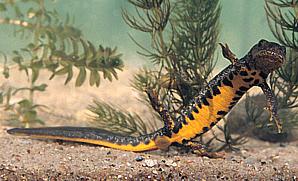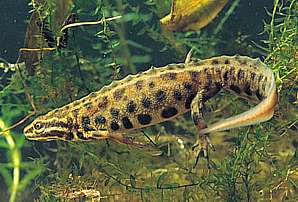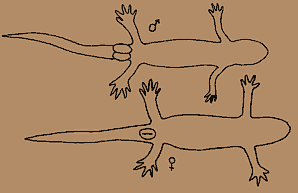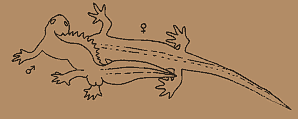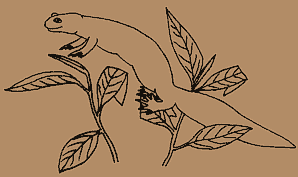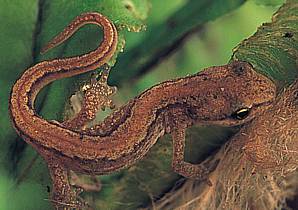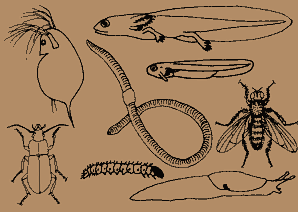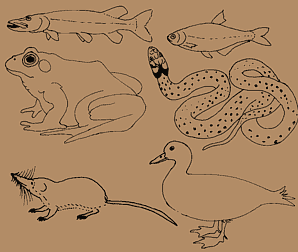|
AMPHIBIANS
|
|||||||||||||||||
Text:
|
Newts
NEWTS Triturus are caudate amphibians, which means that both larval and adult forms have a well-developed tail, contrary to ecaudate amphibians, which possess a tail only during the larval stage. There are four species of newts in Poland: crested newt Triturus cristatus, smooth newt Triturus vulgaris, Carpathian newt Triturus montadoni, and alpine newt Triturus alpestris. There are only two species of newts in the area of the Wigry National Park: crested newt and smooth newt.
Crested newt is present in Europe and Asia Minor; in Poland it is observed mainly on lowlands, and much more seldom in lower parts of mountains. It inhabits larger and deeper water reservoirs as a rule but it can be also seen in ditches, ponds and post-peat reservoirs. During the land period of life, it seeks shelters among shrubbery, under rotten trunks, sometimes in cellars and in earth mounds. In comparison to other newts, during its mating season, it stays in water for a very long time and while on land, it is a significantly stenothermal form. It is quite scarce in the area of the Wigry National Park and its larvae are observed in just few water reservoirs.
Smooth newt is present in the central, northern and Eastern Europe and in Asia. It is common on lowlands in Poland while it is quite scarce in mountains. It is not fussy as regards selection of its habitat. During the mating season, it can be seen in various types of water reservoirs while during the land period of life, it can be seen in damp and shaded places, for example under stones, fallen trees, in burrows of minor mammals or in cellars. It is a common species in the area of the Wigry National Park.
Crested newt is the largest among Polish newts; its males reach the length of 15 centimetres while females even up to 18 centimetres. However, the smooth newt is the smallest and the most delicate species - its females reach the length of 10 centimetres while males - 11 centimetres. The fact that males are larger in comparison to females is an extraordinary phenomenon among amphibians.
The dorsal side of the body of both species is covered with dark, round spots located on a grey or olive-green background, while the ventral side of the body is yellow, orange or red, covered with dark spots. The crested newt is characterised by its specific pigmentation of toes - there are transverse red and yellow stripes located alternately while the dewlap is grey and covered with black spots. During the mating season, males develop a so called "crest" on the dorsal part of the body - this is a fold of skin which runs from the head to the tail with a break in the area of lower back (significantly smaller and more delicate crest also appears at the female of a smooth newt). At the same time, differences in the shape and the size of the cloacal lips, which are present at males and females, are also more significant.
Crested newt wakes up from hibernation in March - April while the smooth newt wakes up much earlier - in February or at the beginning of March, and then enters water reservoirs, which are still being partially covered with ice. The smooth newt begins its mating activity as the first species of our amphibians - the temperature of water is estimated at 4-8°C then. It happens quite often that the mating season of the smooth newt and the crested newt falls out at the same time and in the same water reservoir.
Males of caudate amphibians - contrary to males of ecaudate amphibians - don't have the ability of uttering mating sounds. During creation of a couple, chemical and visual stimuli play the major role. There are glands in the dorsal skin of newts, which produce aromatic substances which are peculiar for the given sex and species and which aim at attracting the partner. The male performs a characteristic dance in front of a female and if she accepts him, he places a spermatophore (that is a cluster of sperm cells), which is then collected by the female with the use of the lips of the cloacae. Then it is not the fertilization that takes place - this process is called insemination. Eggs are fertilized just before their laying. Eggs are laid one by one and then wrapped up into leaves of underwater plants. After approximately two weeks, larvae hatch from these eggs and they measure up to 10 millimetres. Just like at most our caudate amphibians, the front limbs are the first to appear during the development process; the hind limbs are next to appear. The transformation takes place just after the period of three months and then young newts come out to the land.
Newts run a hidden course of life on land. During the day, they seek shelter in damp recesses and they hunt in the evening and at night. They hibernate in rotten, damp trees, under stones, in piles of leaves and often are accompanied by other amphibians. They reach sexual maturity in the third year of their life.
Initially, nourishment of newts mainly consists of microscopic animals, then minor crustaceans (daphnia, Cyclops, ostracods), larvae of water insects and larvae and eggs of other amphibians. While on land, they hunt slugs, lasiocampid moths, spiders as well as insects and their larvae.
Natural foes of newts include predatory larvae of water insects, predatory fish, other newts, frogs, grass snakes, and wild and domesticated water birds - especially ducks, hedgehogs, weasels and rats. Newts have a partial protection thanks to venom produces in venom glands located in their skin.
The basic form of protection of newts is linked to protection of places of their reproduction.
All newts are subject to strict protection in the area of Poland.
|
||||||||||||||||
|
|
|
